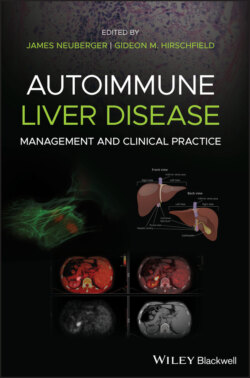Читать книгу Autoimmune Liver Disease - Группа авторов - Страница 2
Table of Contents
Оглавление1 Cover
2 Preface
3 Contributors
4 Abbreviations
5 Introduction
6 Section I: Scientific Basis of Clinical Autoimmune Liver Diseases 1 Introduction to the Physiology, Immunology and Pathology of the Liver and Biliary Tree Liver Cell Types and Organization Hepatic Metabolism Hepatic Transport Systems Drug Metabolism Bile Formation, Secretion and the Enterohepatic Circulation Death and Regeneration of Hepatocytes Cholangiocyte Reaction to Biliary Damage Protective Role of Biliary HCO3− Secretion Cholangiocytes and Immunity Biochemical Markers and Patterns of Hepatic Injury References 2 Concepts of Autoimmunity Relevant to Autoimmune Liver Diseases Introduction Role of Innate and Adaptive Immunity in Autoimmunity in the Context of the Liver as an Immune Organ Generation and Maintenance of Tolerance to Self‐antigens Risk Factors for Autoimmune Diseases Loss of Immune Tolerance to Autoantigens and Perpetuation of Autoimmune Diseases Prevention of Autoimmunity and Therapeutic Control of Autoimmune Diseases References 3 Genetics and Risk of Autoimmune Liver Diseases Introduction HLA Associations in Autoimmune Liver Disease Non‐HLA Associations in Autoimmune Liver Disease Conclusion References 4 Autoantibodies and Understanding of Autoimmune Liver Diseases Introduction Methods of Detection Anti‐nuclear Antibody Anti‐smooth Muscle and Anti‐actin Antibodies Anti‐liver‐kidney Microsomal Antibody Anti‐liver Cytosol Type 1 Antibody Anti‐soluble Liver Antigen Antibody Anti‐neutrophil Cytoplasmic Antibody Anti‐mitochondrial Antibody Anti‐asialoglycoprotein Receptor Antibody Indications for Autoimmune Liver Serology Testing Concluding Remarks References 5 Environmental Exposure and Risk in Autoimmune Liver Diseases Introduction Autoimmunity Primary Biliary Cholangitis Autoimmune Hepatitis Prospectus References
7 Section II: Autoimmune Liver Diseases and Their Clinical Correlation 6 Autoimmune Hepatitis Introduction Definition and Pathophysiology Epidemiology Presentation Diagnosis Treatment Prognosis References 7 Primary Biliary Cholangitis Introduction and Definition Epidemiology Etiopathogenesis Clinical Presentation Diagnosis Natural History Disease Course in the UDCA Era Risk Stratification Treatment Complications of Liver Disease Useful Websites References 8 Primary Sclerosing Cholangitis Introduction Definition Adult PSC Juvenile Sclerosing Cholangitis Conclusion References 9 IgG4‐Related Liver and Biliary Disease Introduction and Historical Perspective Etiology and Pathogenesis of IgG4‐RD Incidence and Prevalence of IgG4‐RD Clinical Characteristics of IgG4‐related Hepatobiliary Disease Diagnostic Criteria, Histologic Features, and Approach to Diagnosis of IgG4‐related Hepatobiliary Disease Radiologic Characteristics of Hepatobiliary IgG4‐RD IgG4‐RD and Relationship with Malignancy Management and Treatment of Patients with IgG4‐RD Conclusions and Future Directions References
8 Section III: Specific Clinical Challenges 10 Managing Acute and Chronic Seronegative Liver Disease Introduction An Approach to Seronegative Acute Liver Failure Potential Causes of Seronegative ALF and Features that Suggest an Autoimmune Pathogenesis Clinical Features of Seronegative ALF Risk Stratification in Seronegative ALF Management of Seronegative ALF An Approach to Cryptogenic Chronic Liver Disease Conclusion References 11 Managing Pregnant Women with Autoimmune Liver Disease Introduction Fertility in AIH Pregnancy Outcomes in AIH Liver‐related Outcomes in Pregnancy Pregnancy in Cirrhosis Safety of Medication in Pregnancy Summary References 12 Bone Health in Patients with Autoimmune Liver Diseases Introduction Prevalence of Osteoporosis and Fractures Pathogenesis Assessment of Bone Disease Prevention and Treatment of Bone Loss Summary References
9 Section IV: Transplantation and Its Role in Autoimmune Liver Disease 13 Recurrent Autoimmune Liver Disease and Its Impact on Clinical Practice Introduction Primary Biliary Cholangitis Primary Sclerosing Cholangitis Autoimmune Hepatitis Conclusions References 14 Recurrent Autoimmune Liver Disease and its Scientific Significance Introduction Recurrence of PBC Recurrence of PSC Recurrence of AIH Concluding Remarks References
10 Section V: Controversies in Autoimmune Liver Diseases 15 Making Sense of Overlap and Crossover Syndromes Introduction General Considerations PBC/AIH Overlap Syndrome PSC/AIH Overlap Syndrome Liver Transplantation Conclusions References 16 The Role of Extrahepatic Autoimmunity in Autoimmune Liver Disease Introduction Epidemiology Autoimmune Thyroid Disease Sjögren Syndrome Systemic Sclerosis Systemic Lupus Erythematosus Rheumatoid Arthritis Celiac Disease Inflammatory Bowel Disease Conclusions Guidelines for Clinicians References 17 Symptoms, Chronic Disease, and Patient Management Background Goals of Treatment Symptoms, Quality of Life, and Health Utility: Key Concepts Symptoms and Their Management in AILD Effective Care Delivery in AILD References
11 Index
12 End User License Agreement
